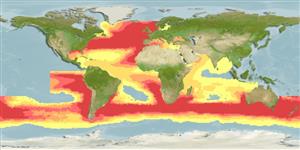Classification / Names
Common names from other countries
Main reference
Size / Weight / Age
Max length : 100.0 cm TL male/unsexed; (Ref. 26340); common length : 40.0 cm SL male/unsexed; (Ref. 3397); max. published weight: 6.0 kg (Ref. 4645); max. reported age: 9 years (Ref. 33866)
Environment
Marine; pelagic-neritic; oceanodromous (Ref. 51243); depth range 0 - 1000 m (Ref. 4388), usually 0 - 200 m (Ref. 89422)
Climate / Range
Subtropical; 12°C - 24°C, preferred 23°C (Ref. 107945); 65°N - 70°S, 180°W - 180°E
Distribution
Atlantic, Indian and South Pacific (Ref. 47377). Western Atlantic: Nova Scotia, Canada and Bermuda (Ref. 7251) to Belize and the Antilles (Ref. 26340). Also found in Brazil (Ref. 47377) and in Argentine (Ref. 2806). Eastern Atlantic: central Norway (Ref. 6697) southward to Algoa Bay, South Africa (Ref. 4388). Highly migratory species, Annex I of the 1982 Convention on the Law of the Sea (Ref. 26139).
Countries | FAO areas | Ecosystems | Occurrences | Introductions
Short description
IUCN Red List Status (Ref. 115185)
Threat to humans
Harmless
Human uses
Fisheries: commercial
Tools
Special reports
Download XML
Internet sources
Estimates of some properties based on models
Phylogenetic diversity index
PD50 = 0.5039 many relatives (e.g. carps) 0.5 - 2.0 few relatives (e.g. lungfishes)
Trophic Level
4.1 ±0.64 se; Based on food items.
Resilience
Low, minimum population doubling time 4.5 - 14 years (Assuming tm>4)
Vulnerability
High to very high vulnerability (71 of 100)
Price category
